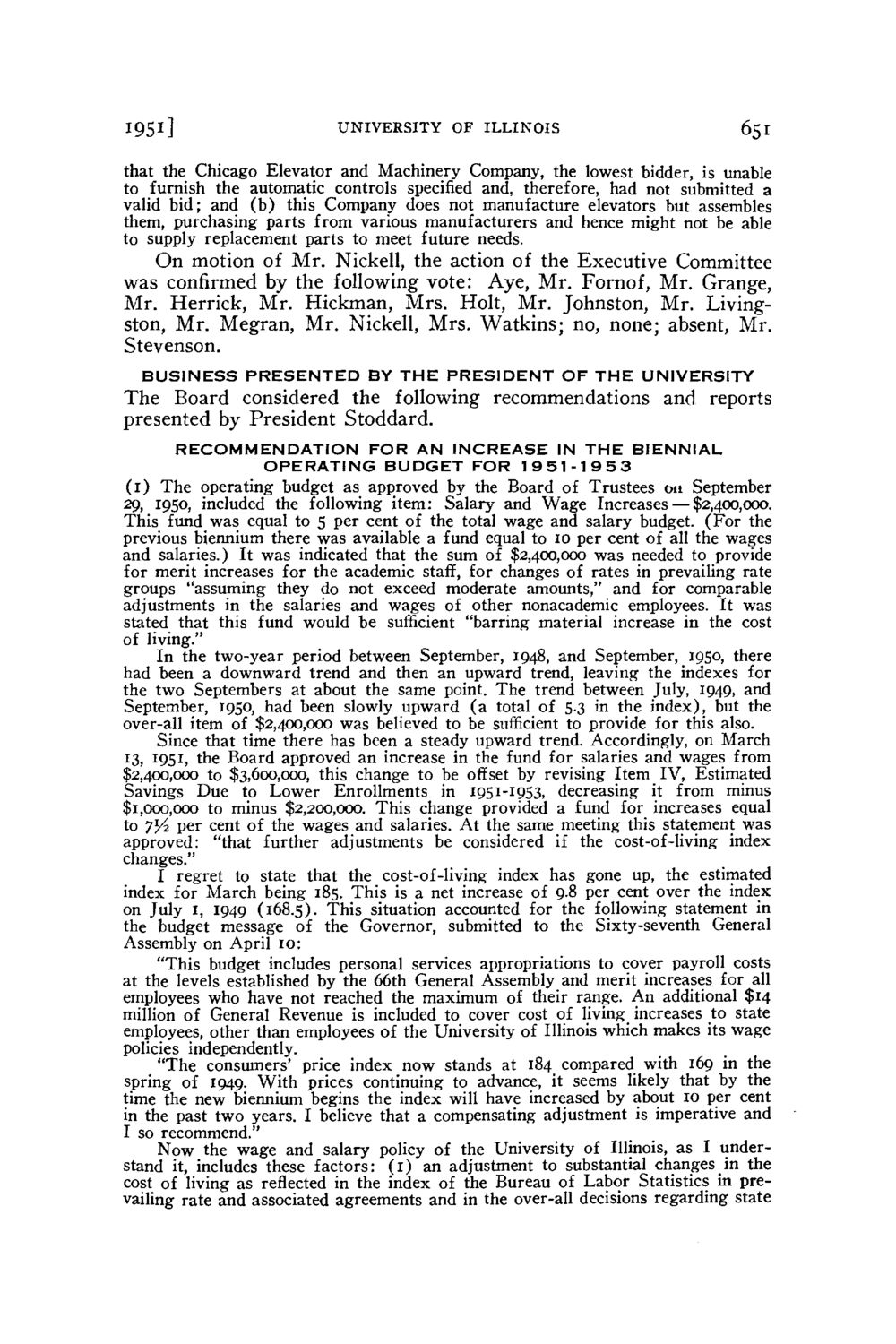| |
| |
Caption: Board of Trustees Minutes - 1952
This is a reduced-resolution page image for fast online browsing.

EXTRACTED TEXT FROM PAGE:
i9Si] UNIVERSITY OF ILLINOIS 651 that the Chicago Elevator and Machinery Company, the lowest bidder, is unable to furnish the automatic controls specified and, therefore, had not submitted a valid bid; and ( b ) this Company does not manufacture elevators but assembles them, purchasing parts from various manufacturers and hence might not be able to supply replacement parts to meet future needs. On motion of Mr. Nickell, the action of the Executive Committee was confirmed by the following vote: Aye, Mr. Fornof, Mr. Grange, Mr. Herrick, Mr. Hickman, Mrs. Holt, Mr. Johnston, Mr. Livingston, Mr. Megran, Mr. Nickell, Mrs. Watkins; no, none; absent, Mr. Stevenson. B U S I N E S S P R E S E N T E D BY T H E P R E S I D E N T O F T H E UNIVERSITY The Board considered the following recommendations and reports presented by President Stoddard. RECOMMENDATION F O R AN I N C R E A S E IN T H E BIENNIAL O P E R A T I N G B U D G E T FOR 1 9 5 1 - 1 9 5 3 (1) T h e operating budget as approved by the Board of Trustees 011 September 29. l95°, included the following item: Salary and Wage Increases — $2,400,000. This fund was equal to 5 per cent of the total wage and salary budget. (For the previous biennium there was available a fund equal to 10 per cent of all the wages and salaries.) It was indicated that the sum of $2,400,000 was needed to provide for merit increases for the academic staff, for changes of rates in prevailing rate groups "assuming they do not exceed moderate amounts," and for comparable adjustments in the salaries and wages of other nonacademic employees. It was stated that this fund would be sufficient "barring material increase in the cost of living." In the two-year period between September, 1948, and September, 1950, there had been a downward trend and then an upward trend, leaving the indexes for the two Septembers at about the same point. The trend between July, 1949, and September, 1950, had been slowly upward (a total of 5.3 in the index), but the over-all item of $2,400,000 was believed to be sufficient to provide for this also. Since that time there has been a steady upward trend. Accordingly, on March 13, 1951, the Board approved an increase in the fund for salaries and wages from $2,400,000 to $3,600,000, this change to be offset by revising Item IV, Estimated Savings Due to Lower Enrollments in 1951-1953, decreasing it from minus $1,000,000 to minus $2,200,000. This change provided a fund for increases equal to 7^2 per cent of the wages and salaries. At the same meeting this statement was approved: "that further adjustments be considered if the cost-of-living index changes." I regret to state that the cost-of-living index has gone up, the estimated index for March being 185. This is a net increase of 9.8 per cent over the index on July I, 1949 (168.5). This situation accounted for the following statement in the budget message of the Governor, submitted to the Sixty-seventh General Assembly on April 10: "This budget includes personal services appropriations to cover payroll costs at the levels established by the 66th General Assembly and merit increases for all employees who have not reached the maximum of their range. An additional $14 million of General Revenue is included to cover cost of living increases to state employees, other than employees of the University of Illinois which makes its wage policies independently. "The consumers' price index now stands at 184 compared with 169 in the spring of 1949. With prices continuing to advance, it seems likely that by the time the new biennium begins the index will have increased by about 10 per cent in the past two years. I believe that a compensating adjustment is imperative and I so recommend." Now the wage and salary policy of the University of Illinois, as I understand it, includes these factors: (1) an adjustment to substantial changes in the cost of living as reflected in the index of the Bureau of Labor Statistics in prevailing rate and associated agreements and in the over-all decisions regarding state
| |